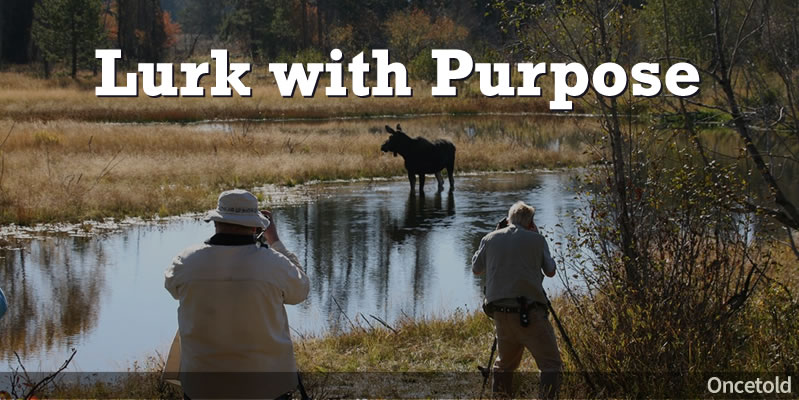
Lurk with a Purpose
In Search of Watering Holes
When embarking on the journey of crafting stories for your podcast, your first step is to arm yourselves with reliable sources. This requires us to venture into the often messy and dark digital realm to pinpoint the spaces where our potential audience congregates and engages online.

Think of yourself as a nature photographer. Then ask yours, “Where do you go if you want to take a quality picture of an elusive or dangerous animal?” The answer: watering holes! Every animal on the planet has to hydrate. This makes watering holes prime real estate for nature photographers.
The same is true for your audience online. They have to go somewhere to talk about their favorite topics. That’s where you come in with your handy-dandy notebook, your keen eye for observation, and the anonymity an Internet browser provides you from the comfort of your laptop.
Your job – for as long as it takes – is to start observing all 315 of your links as if they are wild moose getting a drink at the watering hole.
You are going to lurk!
But not the creepy kind of lurking. No, you are going to lurk with a purpose! To correctly validate each of your 300+ links you need to observe the source in its natural habitat. This means immersing yourself in each source, digging into everything it contains.
Walking Your Sources
After you find your sources you need to walk your sources. Walking your sources when you take the time to evaluate each source for its true value.
The process is simple but will take time.
To walk your sources you first visit the source and explore its limits. How much information does it contain? How old is it? When was the last time it was updated?
Next, you focus on the information it is communicating by asking yourself some objective questions:
- What is the purpose of this source?
- What do they talk about the most?
- What active issues do they bring up?
- What are the latest controversies?
- What do they complain about?
- What solutions do they offer?
- What problems go unsolved?
- What are they not talking about?
This is not a finite list of questions but should be enough to get you going. I believe the best principle to use during this evaluation is to constantly ask yourself, “What jumps out at me that I find interesting?”
What you find interesting and what I find interesting is very subjective. But I find that an interesting source is hard to classify. I just know it when I see it!
Finally, when you find something interesting or that answers a question, you need to record that in your research notes. There is no hard and fast rule for what this should look like.
You should write down any interesting snippet of information that you feel is important to remember. This could include a single word, a phrase, a sentence, an entire idea, a perspective, an image, a quote, or even sound bites or video segments. Don’t make your snippets too long but long enough to understand why they could be useful.
Be consistent in how you document your snippets by recording the link to where you found it and adding a comments section where you write down what you’re thinking or feeling about that snippet at the time you record it. Don’t return to your notes weeks later and not know why you made that note or what it meant to you.
Know Where the Water Is
Animals in the wild know where the water is. In your efforts to evaluate your sources, you should use this metaphor as a guide to knowing who to follow and who to ignore.
During your first few passes through your list of links, you might be overwhelmed with how many links there are to judge. That’s okay. It takes time to know which watering holes are dry.
As you take the time to walk through all 315 links also focus on weeding out the garbage. This requires you to identify weak and dead sites. A weak site has a minimal amount of information, updates, or comments, while a dead site hasn’t been updated in years.
I guarantee that if you spend 2-3 hours observing one source while jotting down page after page of snippets from active discussions, complaints, controversies, interesting insights – whatever catches your attention – you can probably be confident that this is a good source.
Other sources might be tricky. Some weak and dead sites will have a few snippets or observations worth jotting down. Even if you scrutinize a source's activity level, check post dates, and read several interesting articles it may still be hard to tell.
One way that helps me weed out weak and dead sites is to ask myself, “Is what this site is presenting available somewhere else?” If the answer is, “yes”, then I cut it from the list. Better to remove a site that hasn’t posted anything new in a long time than have it take up space on your list.
After going through your entire list you will know a good source from a bad one when you see it!
Your Top 20
Ultimately, you want to prune your list down to at least 20 solid, reusable sources.
These are the healthy sources that you feel you can consistently rely on over the next year. These sites will also be your go-to source for emerging stories and will continuously replenish your episode ideas.





